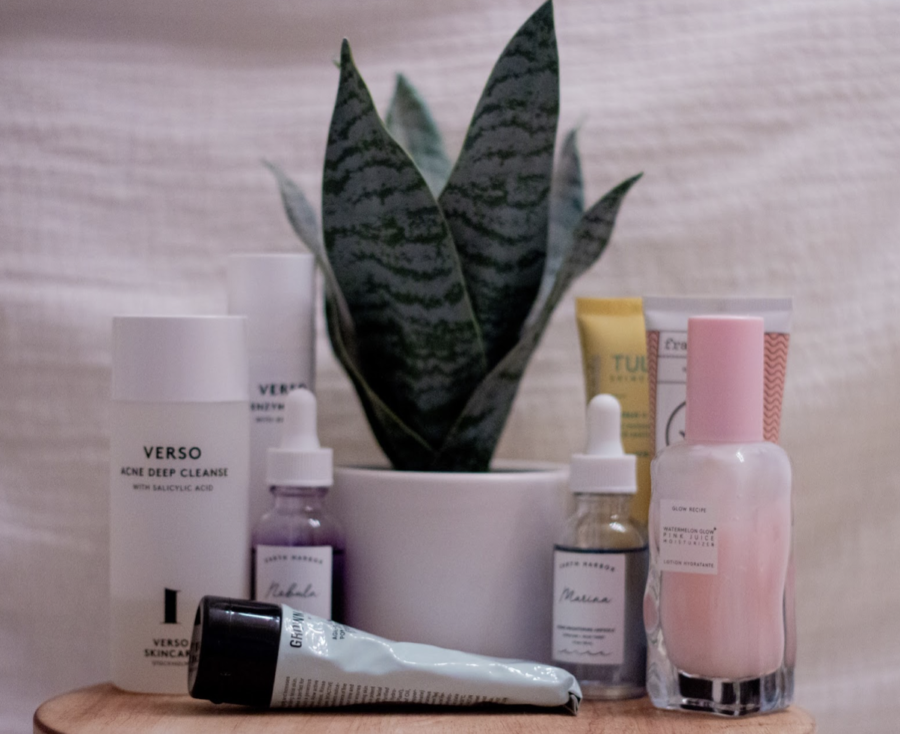How to create a skincare routine
Having a consistent skincare routine is my favorite way to practice self care. Dedicating time daily to do something for myself helps me start and end my day on a good note.
I’ve struggled with acne since middle school, and it’s always been one of my biggest insecurities. I did everything I could think of to hide my acne and would cover my face in makeup every morning before school. However, the makeup barely covered the pimples and blackheads that adorned my face, and ended up causing my breakouts to worsen.
It took years before I realized that I couldn’t just hide my acne, but instead, I had to get to the root of the problem. In seventh grade, I finally paid a visit to a dermatologist who helped me create a skincare routine that worked for me. Here are some tips I learned that might help you create your own skincare routine.
Finding your skin type
Before you purchase any skincare items, you need to know your skin type. To start, wash your face with a gentle cleanser and dry with a towel, and wait an hour. Then, examine your skin in a mirror.
If your face is oily/shiny all over, you have oily skin; you can check this by taking a paper towel and gently blotting your skin. If your face feels tight, rough, itchy or flaky, you have dry/sensitive skin. Lasty, if your skin is oily in your T-zones (your nose, chin and lower forehead area) and dry in other places, (cheeks, upper forehead, hairline) you have combination skin — a combination of oily and dry skin.
Knowing your skin type is crucial to your skincare routine and helps you to determine which products to use. Now that you know your skin type, it’s time to determine what you need in your routine.
Morning skincare routine
Most skincare routines follow the same steps, but the products that you use in your routine will depend on your skin type. In the morning, start by cleaning your face – remember to choose the cleanser for your skin type. This washes sebum, dirt, sweat and other build up and helps to avoid blackheads and pimples.
Next, follow up with a toner. This step is optional, but I highly encourage it. Toner will restore balance and hydration to your skin after cleansing. Toners also help to calm your skin and reduce the appearance of pores.
Then, put on a moisturizing sunscreen. This is the most crucial part of your morning routine. Doctors recommend using an SPF of 30 or higher daily, no matter the weather. SPF protects your skin from the sun’s harsh UV rays, and will help to prevent skin cancer and avoid wrinkles as you age. When looking for an SPF, please keep your skin tone in mind – some products are known to give a “white cast” to people of color.
This last step is optional, but I personally love ending my routine with an eye cream. I use Grace and Stella’s “if eyes could smile” eye cream. This has been my go-to eye cream for the past year, and it’s helped me to lighten the dark circles under my eyes.
Nightly routine
In the evening, start by washing off any makeup worn throughout the day. My all-time favorite makeup remover is the Garnier micellar water, which is great for all skin types. Cleansing balms are another great way to cleanse and remove makeup — they’re also better for the environment since they produce less waste, unlike makeup remover wipes that produce a lot of single use waste. Going to bed without washing off your makeup is one of the biggest mistakes you can make on your journey to clear skin. Not removing your makeup can cause buildup in your pores, resulting in blackheads and pimples.
Next, cleanse your skin and follow up with an exfoliator (use this step only 2-3 nights a week). Everyone’s skin is unique, so I would recommend researching exfoliators and deciding what might work best for you and your skin type.
Lastly, follow up with a moisturizer. Remember to choose one for your skin type; for oily skin, I recommend a lighter gel moisturizer and for dryer skin look for moisturizing creams. If you have dry skin, use a thicker cream at night and reserve the lighter moisturizers for the daytime. For combination skin, you can use the same moisturizer in your morning and night routine, just make sure to look for oil-free moisturizers.
It is important to remember that changing hormones play a role in your acne; sometimes breakouts are inevitable and that is completely normal – especially for women during their menstrual cycle. However, creating a skincare routine can help lessen the severity of your breakout, how often they occur, restore the moisture barrier of your skin and help to improve the overall health of your skin.
Having a consistent skincare routine can greatly improve your skin and your confidence. By spending just a few minutes a day dedicated to your skin, your breakouts will begin to heal and you won’t just see the difference — you’ll feel it!
Link to recommended products:
https://docs.google.com/document/d/13En21DlVZkMESJOE–2ggnIac-ZL-hMKNJ88l-_e0_4/edit#heading=h.xn7c86xm95rm

Sophomore Bree Andrews is a reporter and this is her first year on staff. In her free time she enjoys spending too much time on Pinterest, watching cheesy...













